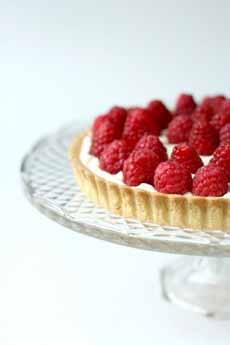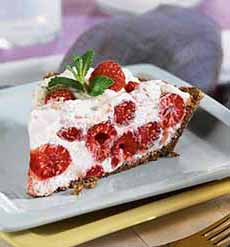|
August 1st is National Raspberry Cream Pie Day. We’d never had a raspberry cream pie, so we whipped one up…and we decided to use a buttery tart crust, which we far prefer to pie crust for its cookie-like flavor and texture.
It’s personal taste, but try it. The Food Holiday Gods won’t be upset that we switched crusts (here’s the scoop on conventional pie crusts.
The only baking in this recipe is of the pie shell or tart crust. The pie is served chilled—mighty refreshing on a hot day.
You can substitute any berry. We also enjoy a strawberry cream pie, blueberry cream pie, or mixed berries. You can get very artistic arranging the colors and textures.
> Check out the different types of pies in our Pie & Pastry Glossary.
RECIPE RASPBERRY CREAM PIE OR TART
This recipe is for a tart crust. For a pie, use your favorite crust recipe or a store-bought crust.
Ingredients
1 cup sugar
1/2 cup flour
1/4 teaspoon salt
3 cups milk
3 egg yolks, slightly beaten
2 tablespoons butter
1 teaspoon pure vanilla extract
Optional: 1/2 cup raspberry purée
1 baked pie crust or tart shell
3 pints raspberries, lightly rinsed and patted dry
Preparation
1. COMBINE. In the top of a double boiler, mix sugar, flour and salt. Stir in milk. Cook 15 minutes over hot water, stirring constantly until thick. Add egg yolks, stir and cook 3 minutes.
2. ADD. Add butter and allow mixture to cool. Stir in vanilla. Add to pie shell and let set in the fridge for a half hour or more.
3. VARIATION. You can also add raspberries to the cream filling, for a double raspberry cream pie. Add the raspberry purée along with the vanilla to the cooled cream mixture.
3. GARNISH. Cover the top of the pie with the raspberries. It’s best to begin at the edges and work your way in. In this way, if you run out of berries, the ungarnished center will look “normal,” not a mistake.
CREAM PIE VS. CREAM PIE
What’s the difference between cream and creme? Just the spelling.
Creme is an Americanization of the French word for cream, crème? (pronounced KREHM), most likely adapted to make the dish sound more special. But why mispronounce another language’s word for cream?
Unless it’s a French recipe, such as Coeur à la Crème, stick to cream.
|
|

[1] A raspberry cream tart, bursting with fresh fruit (photo © Amber B | iStock Photo).

[2] Prefer a creamy raspberry pie? Here’s the recipe from Driscoll’s (photo © Driscoll’s).

[3] Even creamier: a raspberry mousse pie (photo © Dole).
|





